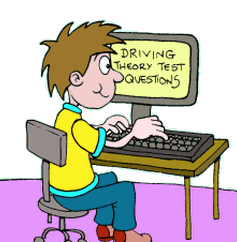Regulations relating to stopping
When you are driving you may not necessarily think much about stopping and simply stop automatically when a light is on red. But infact knowing when you should stop on the road is very important for your own safety, that of your passengers, and other road users too.
There are various occasions on which you must stop. Before reading on, see how many situations in which you must stop you can think of.
Now that you've come up with your list, let's see how many of these you managed to get:
- At a red, amber or red and amber traffic light
- At stop lines by a stop sign
- When there is a stop children sign at a school crossing
- when a member of the police or a traffic warden instructs you to do so
- At a zebra crossing to give way to pedestrians
- At a pelican crossing when the light is red or flashing amber and pedestrians are crossing
- When there are flashing red lights on a motorway or level crossing
- If you are involved in an accident
It is very important that you understand the reasons why you must stop on each of these occasions, and whilst if you observe some drivers you sadly might think that an amber traffic light means speed up, that most certainly is not the case. Always err on the side of caution and only don't stop at the amber if it is unsafe for you to do so, otherwise do always slow down and stop.
Related Articles...
Driving and Eyesight Requirements
If you require glasses in order to meet the requirements for driving legally, then you must ensure that you wear them whilst you drive (or corrective lenses).
There are some conditions that...
Some common engine faults
It is beyond the scope of the articles here to go into detail about how the engine works and what the various parts of it are. For the theory test you won't need to know a great detail about the...
Risk factors when driving: snow and ice
When the snow is falling, there is one big problem - it is hard to see far infront. So like fog, reduced visibility is the problem with snow. And when there is heavy snowfall it can be very hard...
Motorway Driving Tips
Driving on a motorway for the first time can be both exciting and a little daunting - exciting as it is something new whilst daunting as you won't have experienced driving on a motorway before...
Pass Plus Explained
There is an old saying of driving instructors which they state once you've passed your test, and that is that now you really learn to drive. The idea is that you are about to start driving...
Vehicle Test Certificate Explained
The MOT test is no doubt something you have heard of before, but you don't pay that much interest to what it actually is before you are a car driver and faced with the prospect of requiring such a...
Car Driving Test Fees
This article looks at the costs, which were correct as of October 2009.
A standard car and motorcycle theory test costs £31.
In terms of the practical test, the price is a good deal...
Typical brake faults outlined
The brakes are a mechanical object and so it is possible that they will develop problems and not function the way that they should be. This is clearly very dangerous because brakes are one of the...
Driving Theory Stopping Distances
Stopping distances refer to the distance that you car is going to travel from the time that you decide that you need to press the brake through the time that the vehicle physically stops...
Vehicles that cannot be used for a practical test
The vast majority of drivers will of course use the vehicle of their instructor or driving school when they take their practical test and so will not need to worry about the vehicle.
However...
Back to home page of driving theory test questions

